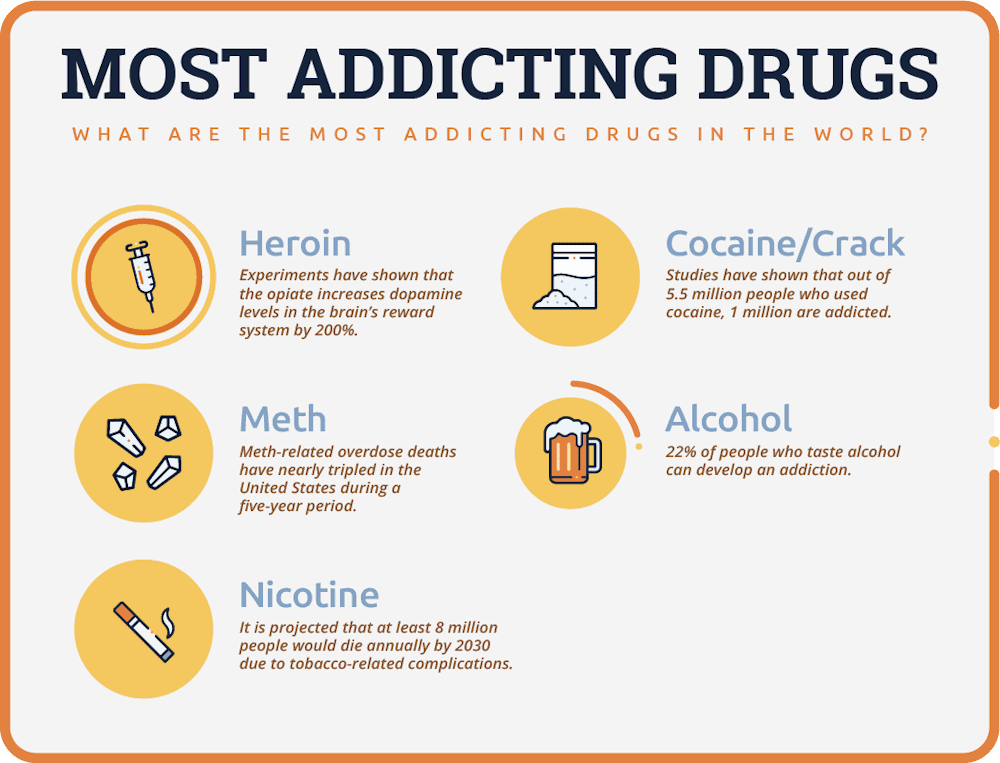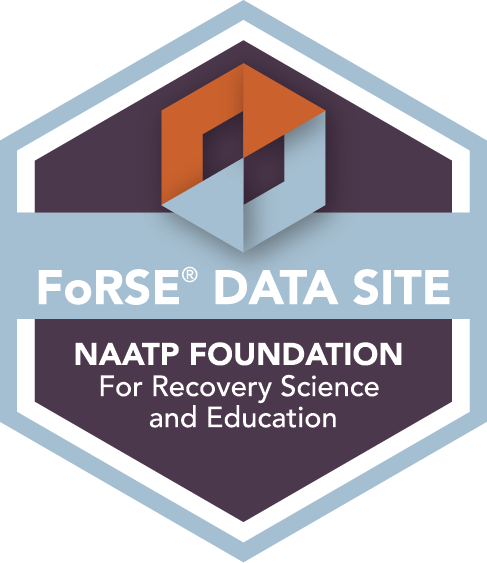According to a report, about 21 million people in the U.S. aged 12 years and older struggle with substance addiction every year and less than half of them seek rehab for drug addiction. The National Institute on Drug Abuse (NIDA) shows expenditure due to lower production in the workplace, legal costs, and criminal justice is up to $600 billion.
What Are the Most Addictive Drugs?

So, which drugs are the most addictive? They are:
- Heroin
- Cocaine/Crack
- Methamphetamines
- Alcohol
- Nicotine
Addictive drugs are commonly used in the medical treatment of various chronic conditions, such as anxiety or insomnia. Such drugs alter how the brain’s signals operate by changing chemical combinations, thus shutting down different parts of the brain.
Consuming low doses of addictive drugs often leads to euphoria, but if you take high doses, you’ll eventually develop tolerance. In the case of prescription drugs, addiction is common because of their ready availability.
Street drugs are equally dangerous. An addictive drug that is not readily available may not cause adverse damage. However, when prescription drugs, particularly pain relievers, are no longer available, many people turn to street drugs and alcohol.
The Department of Health and Human Services (HHS) reported in 2019 that about 20 million Americans live with a drug or alcohol addiction. In the past month:
- About 35.8 million people used illegal drugs
- 140 million people drank alcohol
- 45.9 million people smoked cigarettes
How Drugs and Alcohol Affect the Brain
 The different areas of your brain talk to each other through neurotransmitters (chemical messengers). Dopamine is the main neurotransmitter for drugs of abuse. It carries chemical messages between the neurons (the billions of cells that are your brain).
The different areas of your brain talk to each other through neurotransmitters (chemical messengers). Dopamine is the main neurotransmitter for drugs of abuse. It carries chemical messages between the neurons (the billions of cells that are your brain).
Neurons have receptors that dopamine and other neurotransmitters can unlock to deliver a chemical message. After the dopamine delivers the message, your brain gathers up the dopamine and recycles it. However, drugs of abuse can copy dopamine, stimulate too much dopamine, or prevent the brain from recycling it.
The release of dopamine from a normal rewarding activity like eating or having sex stimulates the pleasure centers in the brain like drugs do. The stimulation from drugs, though, can be far stronger. If substance abuse continues, your brain will slow down production of normal dopamine and other chemical messengers.
Cravings
Therefore, when you stop using a drug, there isn’t enough dopamine for your brain and it will start to crave its effects. A craving is a warning symptom of drug abuse.
Tolerance and Withdrawal
After a while, your brain needs more and more drugs to get the initial effect. Tolerance leads to the cycle of needing more and more drugs just to feel normal. If you don’t get the drug, you feel terrible. This is withdrawal. Tolerance and withdrawal are warning signs of addiction.
The Five Most Addictive Drugs
Even though the brain changes are similar, different drugs cause different effects. In addition, they cause different long-term changes in your brain.
Heroin
Many experts rank heroin as the most addictive drug in the world. How heroin affects the body depends on whether it’s smoked, injected, or snorted. It’s one of the most harmful substances due to the damage it causes to users and society. Heroin and other opioids cause brain changes by mimicking dopamine. One of the main changes is pain relief.
It isn’t important how it gets into your body; it gets to your brain quickly. After using it only a few times, it can be hard to keep from using it again. Experiments have shown that the opiate increases dopamine levels in the brain’s reward system by 200%.
Apart from being one of the most addictive drugs, heroin can also be fatal if it’s injected (the most popular way to use it). The risk for overdose is higher through injection, and there is the additional risk of infection from dirty needles. Tolerance builds quickly, and withdrawal can feel like a bad case of the flu that lasts for several days.
A review published in 2020 by the National Institutes of Health (NIH) explained that about 80% of heroin began by abusing prescription opioids. Moreover, about 400,000 Americans aged 12 and older live with heroin addiction.
Cocaine/Crack
This illegal drug is consumed worldwide, and its market value is more than $75 billion. Cocaine is an addictive stimulant. Cocaine causes the release of large amounts of dopamine, causing a euphoric rush. It interferes with how the brain uses dopamine to send messages from a neuron to the other.
Consuming it may lead to the neurons failing to turn off the dopamine signal, causing the brain’s reward pathways to be activated abnormally. As a result of this, users need stronger and more frequent doses to get the same high they felt in the beginning or just to relieve withdrawal symptoms.
According to the Drug Policy Alliance, crack is a type of cocaine that is smoked and faster acting but almost chemically identical. HHS has reported that in 2019, about 5.5 million people used cocaine, including crack. Of those people, about 1 million became addicted.
Effects of cocaine use include:
- Anxiety
- Confusion
- Insomnia
- Loss of appetite
- Paranoia
- Increased heart rate and blood pressure
Long-term abuse of cocaine causes:
- Clumsiness
- Weight loss
- Loss of memory or ability to think clearly
Methamphetamines
Also called meth or crystal, methamphetamines are seriously addictive substances that can cause euphoric feelings and a physical high. Over the past decade, meth has gained popularity for its euphoric and energetic effects. However, when it comes into your home, it has the power to tear lives apart.
A report published by NIDA in 2019 determined that about 2 million people aged 12 and older used meth in 2019, and about half of those were addicted. Some symptoms of meth addiction include:
- Unusually attentive, talkative, and active
- Rapid weight loss
- Decaying teeth
- Skin rashes
- Complaints about “crawling skin”
- Mood swings that are often irrational and violent
Research on chronic methamphetamine use revealed that there were severe functional and structural changes in the parts of the brain associated with memory and emotions. Although some of the effects on the brain cells from chronic use appear to be at least partly reversible, meth use does increase the risk of stroke. A stroke will cause irreversible brain damage.
Long-term meth abuse can cause:
- Brain damage
- Psychosis
- Organ failure
Withdrawal from meth causes extreme physical and emotional symptoms that begin immediately after the person stops using the drug. Withdrawal is most intense in the first 24 hours and needs to be accomplished in a safe and secure environment such as a professional detox center.
Alcohol
 Alcohol is a depressant. This means that it slows down the brain’s reactions and functioning. Alcohol affects your brain by increasing the levels of dopamine by a range of 40% to 360%. As a result, the more alcohol you drink, the more the brain produces the chemical.
Alcohol is a depressant. This means that it slows down the brain’s reactions and functioning. Alcohol affects your brain by increasing the levels of dopamine by a range of 40% to 360%. As a result, the more alcohol you drink, the more the brain produces the chemical.
Alcohol is legal in many parts of the world and acceptable in social situations. Its popularity and easy availability generally make it more addictive. According to the founder of Global Institutes on Addictions in Miami, “In terms of the sheer number of people addicted, alcohol is the substance with the highest number of cases worldwide.”
Studies reveal that an estimated 22% of people who taste alcohol can develop an addiction. According to the World Health Organization (WHO), about 2 billion people consumed alcohol between 2002 and 2012. In the same period, more than 3 million people died due to being physically damaged by drinking.
Binge drinking can cause memory loss known as a blackout. Long-term alcohol abuse can cause seizures and permanent brain damage.
Nicotine
The primary addictive substance in tobacco is nicotine, and it can be just as addictive as heroin and cocaine. After smoking a cigarette, the lungs absorb nicotine, which then goes to the brain. Experts rank tobacco (nicotine) as fifth in the list of most addictive drugs.
More than two-thirds of those in the U.S. who smoke become addicted at some point in their lives. In 2002, the World Health Organization (WHO) estimated 1 billion active smokers worldwide and projected that at least 8 million people would die annually by 2030 due to tobacco-related complications.
Direct nicotine injection into the bloodstream of animals increases dopamine levels by 25% to 40%. Smoking cigarettes can lead to several health problems, including:
- Constriction of blood vessels
- Lung cancer
- Poor vision
- Heart disease
- High cholesterol
- Loss of appetite
- Wrinkles
Help is Available at Northern Illinois Recovery Center
These are some of the most addictive drugs affecting many people in society today. Addiction can cause a lot of damage in all areas of life, including relationships, jobs, school, and social places. Seeking earlier treatment in a holistic rehab center can help you avoid the severe consequences of drug dependency.
At Northern Illinois Recovery Center, we are experienced in the treatment of these and other addictions. Our professional alcohol and drug detox center can help you or your loved one clear the toxic substance from the body and prepare for treatment. In addition, we have five levels of care, so you will enter at the most effective level and won’t leave until you’re ready. Your program will be custom designed just for you.
Because these drugs cause physical changes to the brain, a person cannot simply choose to stop being addicted to them. These addictions require medical treatment to help someone get off the harmful drugs — and stay off them. Contact us now to schedule an appointment.




